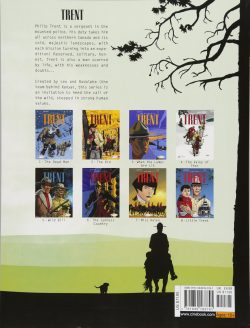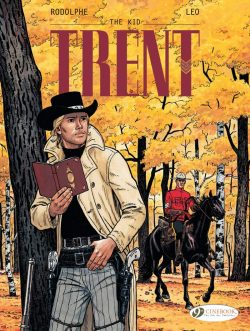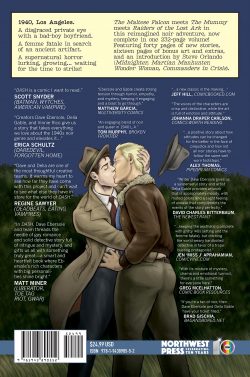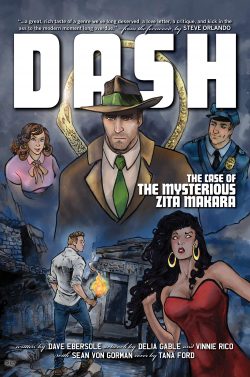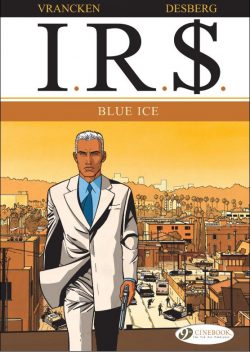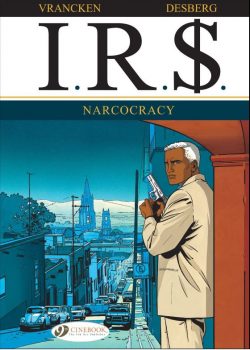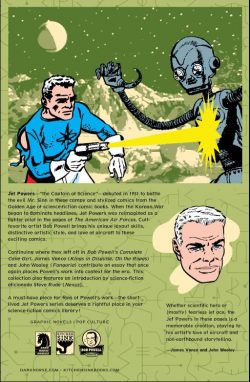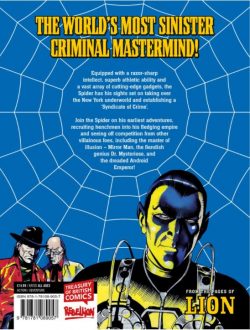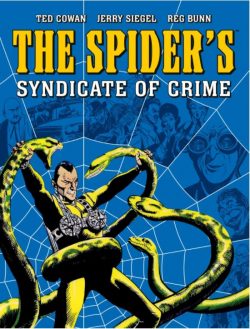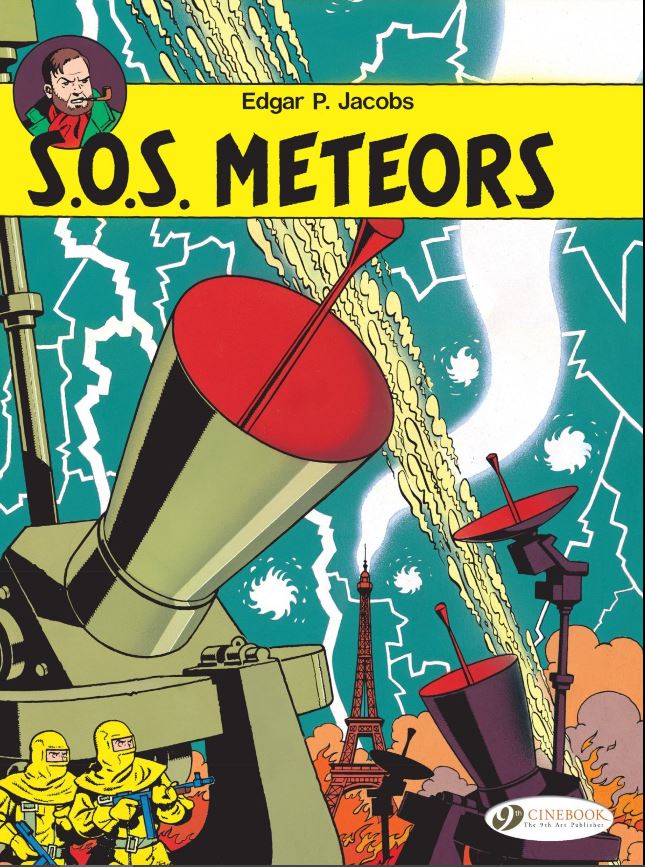
By Edgar P. Jacobs, translated by Jerome Saincantin (Cinebook)
ISBN: 978-1-905460-97-7 (Album PB)
Not all of 2021’s comics milestones are Anglo-American affairs. These guys are celebrating 75 glorious years of uncanny exploits and still going strong. Bon Anniversaire, mes amis …
Master storyteller Edgar P. Jacobs pitted his distinguished duo of Scientific Adventurers Professor Philip Mortimer and Captain Francis Blake against a wide variety of perils and menaces in stunning yarns combining science fiction scope, detective mystery suspense and supernatural thriller action, rendered in the same ageless and inviting Ligne Claire style which first made intrepid boy reporter Tintin into a global sensation.
The strip debuted in the premier issue of Le Journal de Tintin (dated 26th September 1946): an international anthology comic with multi-language editions in Belgium, France and Holland. The magazine was edited by Hergé himself, with his eponymous star ably supplemented by a host of new heroes and features designed to inspire young readers of the post-war world…
S.O.S. Météores began serialisation in the January 8th 1958 issue: running until April 22nd 1959 before being subsequently collected six months after the conclusion as the 8th album of the drama-drenched epic escapade. It was just in time for the Christmas rush.
In 2009 the tale was translated into English as Cinebook’s 6th Blake and Mortimer release, and – subtitled ‘Mortimer in Paris’ – opens here with the incomparable boffin in the City of Lights, answering a Gallic colleague’s pleas for assistance.
Like all his unhappy ilk, meteorologist Professor Labrousse is shouldering the brunt of public ire over freak weather events which are systematically bringing France to its knees. When Mortimer arrives, he experiences for himself the chaos tumultuous storms are inflicting upon the traffic-heavy metropolis. Thankfully, the embattled weatherman has despatched a taxi to collect the weary Englishman and bring him to the relative calm of suburban enclave Jouy.
Both driver and passenger are unaware of a flashy American car covertly dogging them. As conditions steadily worsen, the ride becomes truly hazardous, leading to an inevitable crash. Separated from the driver and blindly wandering in the storm, Mortimer plunges into a lake and barely manages to scrabble to safety.
Finding his way back to the road, the exhausted scientist thumbs a lift to Labrousse’s house and is warmly welcomed. Of the taxi driver, however, there is no trace…
The old chums discuss the catastrophic conditions and uncanny events long into the night, but the next morning further deliberations are curtailed when the police arrive, eager to interview the Englishman about a certain cab driver’s disappearance…
Deeply troubled, the learned men attempt to retrace Mortimer’s steps and discover the terrain is completely different from Englishman’s memories. They also encounter a thug and his immense dog going over the same sodden ground. The strangers are clearly following the orders of a boss who keeps well hidden, and a violent altercation is barely avoided with a simple whistle from the unseen voyeur…
Eventually the lifetime experience of the local postman enables the baffled British boffin to solve his geographical conundrum, and a recovered trail leads to a nearby estate with huge walls patrolled by the same terrifying hound he met earlier. Well-versed in surveillance procedure, Mortimer prepares to probe further but is distracted when a sudden snowstorm begins. Determinedly he returns later, well-prepared and using the blizzard as cover to investigate the estate. It proves to be a tremendous mistake…
Next morning in Paris, Divisional Commissioner Pradier of French Intelligence welcomes a counterpart from Great Britain, looking into an espionage ring at work in France. Captain Francis Blake’s keen insight quickly scores a hit: opening up new leads that seemly connect to the weather conditions tormenting the nation. However, on meeting hastily-summoned Labrousse, Blake learns old comrade Mortimer has vanished after announcing that the aberrant meteorology is man-made…
Travelling to Jouy with the horrified weatherman, Blake makes a shocking impression on Labrousse’s usually-affable neighbour as the strange atmospheric conditions are abruptly compounded with odd little accidents and frustrations that can only be seen in total as concerted enemy action…
The saga kicks into high gear when Blake recognises old – and presumed dead – enemies and is chased through unrelenting arctic conditions back to Paris in a deadly, hair-raising game of cat-&-mouse which culminates in another confrontation with his most implacable foe…
Assisted by Pradier’s forces, Blake soon has the villains on the run, spectacularly fleeing over Parisian rooftops, but the big fish again escapes, and our heroes face the fact that they may never know what has become of Mortimer…
In Jouy, however, the irascible researcher has made good use of his time. Incarcerated with diabolical Professor Milosh Georgevich – who has used the vast resources of an aggressor nation to weaponise weather in advance of an audacious scheme to invade France for the third time in a century – Mortimer acts alone and escapes his jailers. Picking up an unexpected ally as he tries to sabotage the colossal climate engines, the Prof is utterly unaware that his greatest friend has picked up new clues and is closing in on the plotters…
Moody and comparatively low-key until the final act – when tensions build to explosive heights and a Bond-Movie finish – S.O.S. Meteors is a splendid romp packed with astounding action, scads of sinister deviltry and a blockbuster climax to delight spy-buffs and all devotees of the Distinguished Duo.
Addictive and absorbing in the truest tradition of pulp sci-fi and Boy’s Own Adventures, Blake and Mortimer are the epitome of dogged heroic determination and the natural successors to such heroic icons as Professor Challenger, Bulldog Drummond and Richard Hannay, delivering grand Blood-&-Thunder thrills, chills and spills in timeless fashion and with a mesmerising visual punch.
Any kid able to suspend modern mores and cultural disbelief (call it alternate earth history or bakelite-punk if you want) will enjoy the experience of their lives…
This Cinebook edition – available in paperback and digital editions – also includes excerpts from two other B&M albums plus a short biographical feature and publication chart of Jacobs’ and his successors’ efforts.
Original edition © Editions Blake & Mortimer/Studio Jacobs (Dargaud-Lombard S. A.) 1989 by E.P. Jacobs. All rights reserved. English translation © 2009 Cinebook Ltd.

